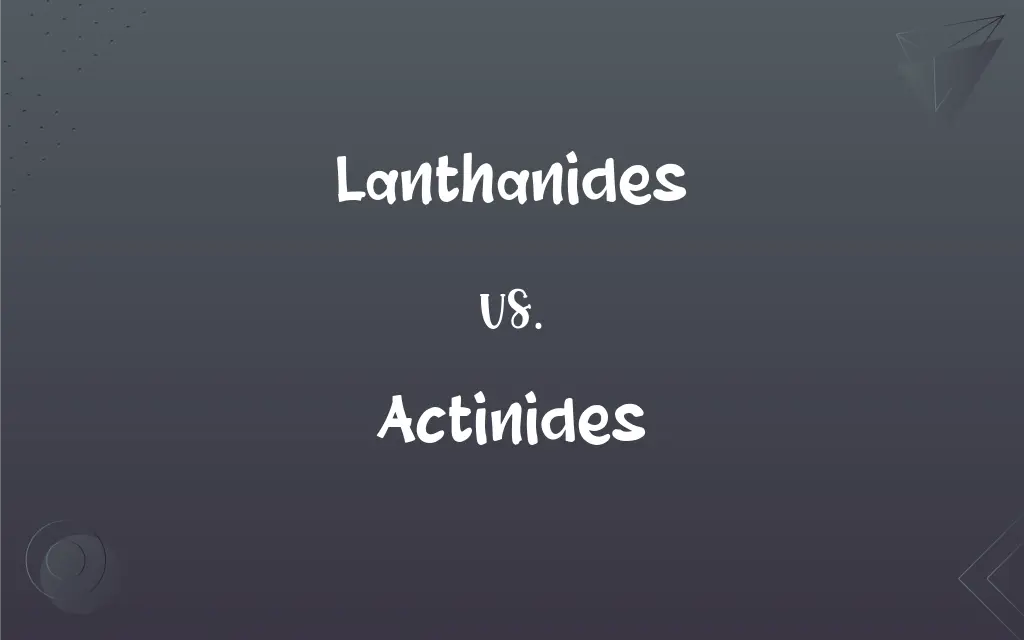Lanthanides vs. Actinides: What's the Difference?
Edited by Aimie Carlson || By Harlon Moss || Updated on October 24, 2023
Lanthanides are the 15 metallic elements from atomic numbers 57 to 71, while actinides are the 15 elements from atomic numbers 89 to 103.

Key Differences
Lanthanides are a series of chemical elements found in the f-block of the periodic table, specifically from atomic numbers 57 (lanthanum) to 71 (lutetium). They are known for their high magnetic susceptibility and are commonly used in various high-tech applications such as the manufacture of strong permanent magnets. On the other hand, actinides are also elements in the f-block but span from atomic numbers 89 (actinium) to 103 (lawrencium). Actinides are best known for their radioactive properties and are often associated with nuclear technology.
Lanthanides are typically characterized by the filling of their 4f orbitals. They showcase similar properties amongst each other, such as their shiny metallic appearance and high melting points. Actinides, in contrast, see the filling of their 5f orbitals. While lanthanides have similarities, actinides display a much broader range of properties, primarily due to the influence of the 5f electrons and the increasing predominance of their radioactive characteristics.
The natural occurrence of lanthanides is more widespread compared to actinides. Lanthanides can be found in various minerals on Earth, with many of them being relatively abundant. Actinides, conversely, are far less abundant. Many of the heavier actinides have been synthesized in laboratories and do not occur naturally.
While both lanthanides and actinides play significant roles in technological advancements, their applications vary greatly. Lanthanides are essential in modern technologies like hybrid car batteries, wind turbine generators, and certain types of lighting. Actinides, with their radioactive properties, find primary application in nuclear reactors, as fuel, or in the production of nuclear weapons.
Both lanthanides and actinides have significant scientific importance. While lanthanides help in understanding the electronic structure and properties of metals, actinides provide insights into the behavior of heavy elements, their radioactive decay, and their potential applications in various fields.
ADVERTISEMENT
Comparison Chart
Atomic Numbers
57 to 71
89 to 103
Orbital Filling
4f orbitals
5f orbitals
Natural Occurrence
Widespread in various minerals
Less abundant; many are synthetic
Typical Uses
Magnets, batteries, lighting
Nuclear reactors, nuclear weapons
Main Characteristics
High magnetic susceptibility
Radioactive properties
ADVERTISEMENT
Lanthanides and Actinides Definitions
Lanthanides
Lanthanides exhibit similarities in their chemical behavior due to the shielding effect of their 4f electrons.
The chemical reactivity of lanthanides makes them essential in several catalytic processes.
Actinides
Actinides are a series of 15 chemical elements with atomic numbers 89 to 103, characterized by their radioactive properties.
Uranium and thorium, both actinides, are significant for the nuclear industry.
Lanthanides
Lanthanides are a series of 15 metallic chemical elements with atomic numbers 57 to 71.
Many modern technologies, such as smartphones, utilize lanthanides in their components.
Actinides
These elements primarily fill their 5f orbitals as the series progresses.
The electronic structure of actinides can lead to unique magnetic and electronic behaviors.
Lanthanides
These elements predominantly fill their 4f orbitals as they progress across the series.
The unique electronic configuration of lanthanides contributes to their magnetic properties.
Actinides
Many actinides are synthetic and are produced in laboratories due to their short half-lives.
Scientists continuously study actinides to understand their potential applications.
Lanthanides
Lanthanides are known as rare earth metals characterized by their shiny appearance and high melting points.
The extraction of lanthanides from ores is crucial for various industries.
Actinides
Actinides play a crucial role in nuclear technology, both for energy and weaponry.
The controlled fission of actinides powers many nuclear reactors globally.
Lanthanides
These metals are essential in modern technological applications, including magnets and lighting.
Lanthanides play a pivotal role in the production of energy-efficient LED lights.
Actinides
The series begins with actinium and includes heavy elements like plutonium and americium.
Actinides like plutonium have been pivotal in historical nuclear weapons research.
Lanthanides
Plural of lanthanide
Actinides
Any of a series of chemically similar, radioactive elements with atomic numbers ranging from 89 (actinium) through 103 (lawrencium). Also called actinoid.
Actinides
Plural of actinide
FAQs
Where are actinides located on the periodic table?
Actinides are located in the f-block, spanning atomic numbers 89 to 103.
Can lanthanides be found in nature?
Yes, lanthanides can be found in various minerals on Earth.
Are all lanthanides radioactive?
While some lanthanides have radioactive isotopes, they are generally much less radioactive than actinides.
Are all lanthanides hard and shiny?
Generally, yes, lanthanides are hard, shiny metals.
How many actinides have been synthetically produced?
Most actinides heavier than plutonium, such as curium and berkelium, are synthetically produced.
What makes lanthanides important for the tech industry?
Their magnetic properties and use in various components make them essential.
What are lanthanides?
Lanthanides are a series of 15 metallic elements with atomic numbers 57 to 71.
Why are actinides significant in nuclear technology?
Actinides like uranium and plutonium are essential for nuclear reactors and weapons due to their radioactive properties.
How do actinides differ from lanthanides in terms of electronic configuration?
Actinides primarily fill their 5f orbitals.
Which actinide starts the actinide series?
Actinium starts the actinide series.
What's the primary orbital filling for lanthanides?
Lanthanides predominantly fill their 4f orbitals.
Are lanthanides used in everyday technology?
Yes, lanthanides are used in items like smartphones, magnets, and LED lights.
How do lanthanides react with air?
Lanthanides react with air and often tarnish over time.
What role do actinides play in nuclear weapons?
Actinides like plutonium and uranium are primary materials in the production of nuclear weapons.
Can actinides be used for medical purposes?
Yes, some actinides, like americium, are used in smoke detectors, and others have potential medical applications.
What makes actinides unique among elements?
Their radioactive properties and involvement in nuclear technology set them apart.
Are actinides safe to handle?
Many actinides are highly radioactive and require precautions when handled.
What is the first element in the lanthanide series?
Lanthanum is the first element in the lanthanide series.
Why are lanthanides called rare earth metals?
Though not very rare, they were historically challenging to separate, leading to the term "rare earth."
How many actinides are naturally occurring?
Only thorium and uranium are abundant in nature, with some traces of neptunium and plutonium.
About Author
Written by
Harlon MossHarlon is a seasoned quality moderator and accomplished content writer for Difference Wiki. An alumnus of the prestigious University of California, he earned his degree in Computer Science. Leveraging his academic background, Harlon brings a meticulous and informed perspective to his work, ensuring content accuracy and excellence.
Edited by
Aimie CarlsonAimie Carlson, holding a master's degree in English literature, is a fervent English language enthusiast. She lends her writing talents to Difference Wiki, a prominent website that specializes in comparisons, offering readers insightful analyses that both captivate and inform.































































